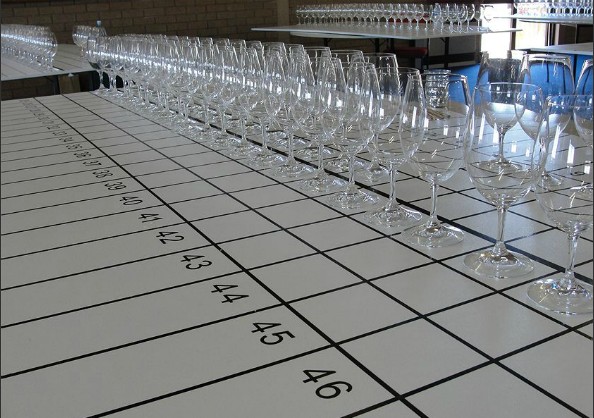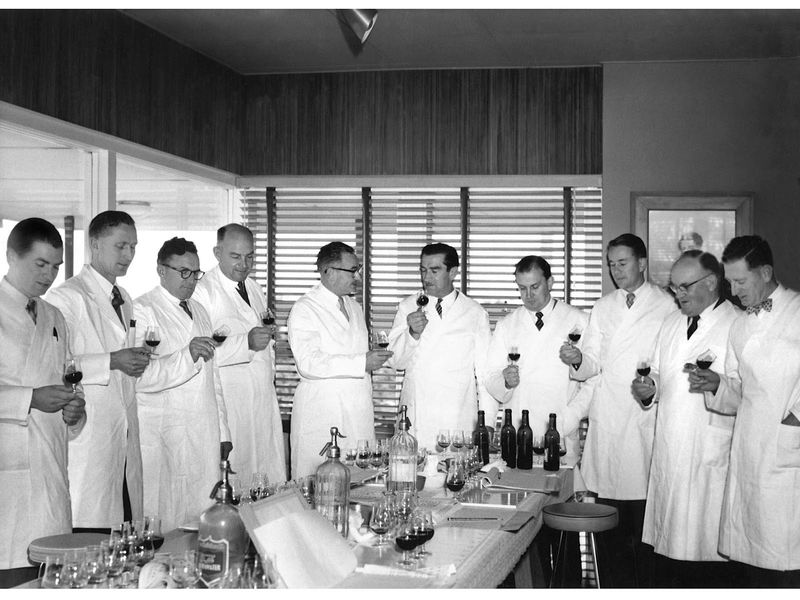XXXXXXXXXXXXX
Our Mission is to take the Bull out of Wine
I’m not sure why James Halliday decided just now to write a post about Alex Mayyasi’s piece from last year. It kind of plays into our premise that most people including wine judges have trouble telling expensive wines from more humble ones.
James comes out punching, right from the first paragraph: ‘Alex Mayyasi’s blog is proof positive that wine bloggers are, by and large, distinguished by their abysmal lack of knowledge, whether they are blogging about some specific aspect of wine, or making sweeping judgements about wine in general.’
Killing the messenger
How ironic that James chooses to begin his riposte with a sweeping judgement about bloggers. The next paragraph is more of the same: ‘He leaps from one point to the next, and having started with the proposition that wine is bullshit and that experts cannot tell good wine from bad, comes to a conclusion that, on its face, makes everything he has written on the way through incorrect or misleading.’
We’re not off to a good start, and it doesn’t get any better. James doesn’t argue with the facts presented, but attacks the writer on multiple fronts and then deplores the poor quality of European judges. Read it, and you wonder why he bothered. Did James write this sloppy little post, or was it one of his staffers?
There are 3 reasons I started Best Wines Under $20
- Misleading wine show results: too many ordinary wines groaning under the weight of their trophies and gold medals turn out to be vin ordinaire.
- The challenge of finding great wines that don’t cost and arm and a leg. (Let’s face it: anyone can choose great wines when price is no object)
- To take the bullshit out of wine.
We want to bring wine back into the real world, where real people pay real money for wine and enjoy it with real food. Wine writers rarely buy their own wine since they’re inundated with samples, and they lose touch with reality. Consumers buy a bottle of wine with hard-earned cash and get cheesed-off when the wine’s a dud.
Wine judging is a hit and miss affair. James can rant and rave as much as he likes but the studies Alex Mayasssi talks about are real and well known. In these studies, judges are given the same wines at different times and their scores are all over the place. Other studies show that judges tend to favour the biggest wines in a line-up simply because they stand out. We’ve seen this time and again with red wines.
 Wine judging is also inconsistent. A wine will often win two trophies and a gold medal in Melbourne, a bronze in Perth and nothing in Adelaide or Sydney. We’re talking a range of 95 points 80 points here (outstanding to pretty ghastly), and it happens all the time.
Wine judging is also inconsistent. A wine will often win two trophies and a gold medal in Melbourne, a bronze in Perth and nothing in Adelaide or Sydney. We’re talking a range of 95 points 80 points here (outstanding to pretty ghastly), and it happens all the time.
An inconvenient truth – our judging system is broken
Of course it’s hard for James Halliday, who has dominated the Australian wine stage like a Heldentenor in Wagner’s Ring Cycle, to accept that wine judging is not a reliable business. But it isn’t.
Some years ago, Chris Shanahan wrote about the Canberra show that ‘The judges, led by Domaine Chandon’s Dr Tony Jordan in this instance, really should be made to stand in the corner. Either that or we accept Minchinbury, Carrington, Great Western, and Seaview at $4-$7 as better wines than Salinger 1991 ($30)?’
We’ve shaken our heads too often over crook wines adorned with bling: Jacobs Creek Riesling 2012 won a stack of gongs, including a trophy and 96 points in Melbourne, yet we saw it as a cleverly contrived concoction with industrial overtones (it’s made by the oil tanker load and sells for $6.50 a bottle).
A similar example was the $7 Wolf Blass Red Label Shiraz Grenache 2010, which won 2 trophies and 2 golds in Adelaide and Melbourne a while back. Halliday heaped praise on it at the time: ‘What an amazing wine,… vibrant purple-crimson, with totally delicious red berry and spice flavours, … 94 Points.’
I thought it was industrial autoplonk of the worst order, and looked for other reviews. ‘I had to try this wine,’ David Hemmings wrote in his blog. ‘Unfortunately … I found the wine to be incredibly underwhelming. With a medicinal nose, the palate of stewed red and dark berries lacked fruit intensity, acidity, complexity and oak influence – 83 points.’ Was James served a different wine?
We’ll let Max Allen have the last word on this: ‘The traditional form of wine judging in Australia, the one that developed from the Royal Agricultural Society Shows – you know, old geezers standing around in white coats with clipboards, working their way along a line-up of 100 young shirazes before lunch and awarding points out of 20 as if the wines were heifers or sponge cakes – is deeply, deeply flawed.’ More Here What’s wrong with our wine show system Judges reward boring wines, we look for exciting ones
Judges reward boring wines, we look for exciting ones
In an interview with Decanter, Rick Kinzbrunner from Giaconda said Australia Makes Boring Wine, and that our wine shows have become moribund. ‘… [The show system] just drives wines to a certain level of interesting boredom,’ he says, ‘clean boredom.’ He asks: ‘Why do winemakers run the show? They’re not the people who drink the wine. It’s absolutely crazy. You should have consumers in charge, with a small winemaking contingent.’
At BWU$20, consumers are in charge. Are we not prone to the same errors of judgement? Of course we are, but we don’t assess wines the way our judges and wine reviewers do: lined up on benches in endless rows. We assess wines with and without food, over several days, a few at a time.
We look for different qualities than our wine judges, I suspect: Appeal, attitude, life, energy, charm, style, food-friendliness and drinkability. ‘The most difficult skill for a judge to acquire is the ability to taste with drinkability (and the food context) in mind,’ says Decanter’s Andrew Jefford. Drinkability or slurpability may be terrible words, but they’re essential qualities for us.
You don’t need to spend big money
The $10 Devils Ridge McLaren Vale Shiraz, the $15 Ninth Island Pinot Gris 2013, the $20 St Clair Pinot Noir 2012 and the$25 Pelorus NV all have those qualities in spades. Our great fortune is that price is not a reliable guide to wine quality in this country, and that’s the great premise BWU$20 is built on. Other examples we point to on our website are
- $785 Gange 2008 matched by $17 Robert Oatley 2011 Shiraz
- $17 Pepperjack 2012 wins Visy Great Australian Shiraz Challenge 2013
- Grant Burge Filsell 2010 – World’s Greatest Shiraz in 2013 Winstate Comp
- $28 Mountadam High Eden Chardonnay 2010 beats Australia’s best
- $28 Xanadu Cabernet Sauvignon 2009 tops GTW’s 2013 Cabernet Tasting
- $19 Frogmore Creek Riesling 2013 gets our nod for best Riesling of that year
The first example illustrates the different things wine pros and consumers look for in wine. The Grange is a big, tight, densely packed red built for the long haul, while the Bob Oatley Shiraz is a silky smooth but pretty simple red with soft ripe fruit.
The Pepperjack is the poor man’s Grange, big, tight, densely packed … Not a lot of class or polish here but a ton of flavour, certainly not the best Shiraz going but good value on permanent discount.
The Grant Burge Filsel had much more polish, we really liked it and gave it 95.
The Mountadam Chardy 2010 is a class act, we agree with the Pommy judges.
Yes, sometimes we agree with the judges: we raved about the Xanadu Cabernet after we tasted it at the Gourmet Traveller Wine tasting. Late in 2013, it won 3 trophies at the Canberra National Show including best wine of show.
We threw in the Frogmore Creek to show the enormous value in Aussie Rieslings. We could’ve listed a dozen more – Sons of Eden Freya 2012, Heirloom 2012, Leo Buring Dry Riesling Clare Valley 2013 …
James, we all have a voice now. Get used to it
It’s not like the old days when you published books and no one argued with you. The internet has changed that, and wine bloggers are everywhere. The good ones will build a following, and the ordinary ones will fade. Your star will fade too if you keep posting sloppy critiques and point scores that make wine drinkers shake their heads.
When we wrote the short post When it comes to Wine, Whom can you trust? about a wine you scored as outstanding that clearly was anything but, the feedback from a number of subscribers was that they’d long stopped taking your scores seriously.
When we linked to your post about Alex Mayyasi in our weekly mailer, we received this response from a subscriber: ‘… So keep going after them, Kim. It’s time we all develop the confidence to choose wines that appeal to our own palates rather than give exaggerated credence to some arbitrary numbers provided by so-called experts who are often captives of the inwardly looking industry giants.’
By way of a footnote, I’ve enclosed a table of selected results from the 2013 Visy Great Aussie Shiraz Challenge. As you go down the list, you’ll see various wines with prices around $100 or more until you stop at Penfolds RWT 2010 on 15.7 – just made a bronze medal.
|
2012 Pepperjack Shiraz |
W Salter & Son |
Gold, First Place, The 2013 Visy Great Australian Shiraz Challenge Trophy |
19.0 |
$28.00 |
|
2012 Ingoldby Shiraz |
Ingoldby |
Gold, Graphix Labels & Packaging Trophy for the Best Shiraz under $25.00 |
18.8 |
$20.00 |
|
2010 Seppelt Chalambar Shiraz |
B Seppelt & Sons |
Gold |
18.7 |
$26.99 |
|
2011 Rosemount Balmoral Syrah |
Rosemount Estates |
Gold |
18.5 |
$74.99 |
|
2010 Seppelt St Peters Shiraz |
B Seppelt & Sons |
Silver |
18.0 |
$79.99 |
|
2009 Stonewall Shiraz |
Peter Lehmann Wines |
Silver |
17.3 |
$100.00 |
|
2010 Saltram Single Vineyard Shiraz |
Saltram Wine Estate |
Bronze |
16.3 |
$90.00 |
|
2004 The Exception Shiraz |
Fowles Wine |
Bronze |
16.0 |
$125.00 |
|
2009 Wolf Blass Platinum Shiraz |
Wolf Blass Wines |
Bronze |
16.0 |
$190.00 |
|
2010 Old Block Shiraz |
St Hallett Wines |
Bronze |
15.7 |
$100.00 |
|
2010 Penfolds RWT Barossa Valley Shiraz |
Penfolds Wines |
Bronze |
15.7 |
$150.00 |
|
2010 Penfolds Bin 150 Marananga Shiraz |
Penfolds Wines |
Bronze |
15.7 |
$75.00 |
Kim
